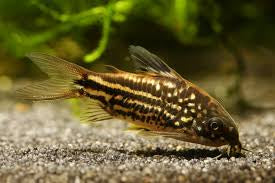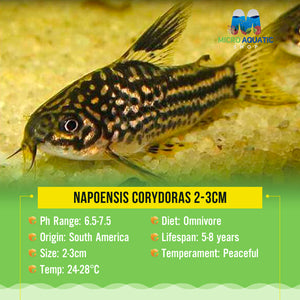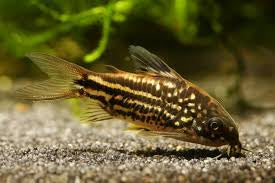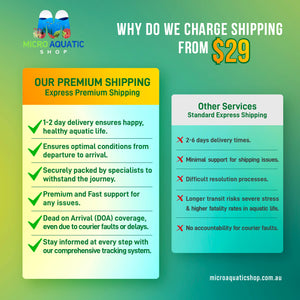Napoensis Corydoras 2-3cm
Guarantee Safe Checkout
Corydoras Napoensis - Perfect Bottom Dweller for Aquariums
In Australia, aquarium lovers are drawn to Corydoras Napoensis. This small freshwater catfish is a favourite in many homes. It's not just cute; it's also key to keeping our aquariums healthy. Corydoras Catfish with distinctive barbels and patterned scales, swimming in a natural aquarium setting. The Corydoras Napoensis, also known as the Leopard Cory or Spotted Cory, is a standout. Its unique spots and calm nature have won many hearts. We'll explore its world, from its natural home to how to care for it in your aquarium.
Key Takeaways
- Corydoras Napoensis is a small, peaceful freshwater catfish with a unique spotted pattern
- This species is an excellent choice for the bottom of your aquarium, helping to maintain a clean and balanced ecosystem
- Corydoras Napoensis originates from the South American continent and requires specific water parameters and tank conditions to thrive
- With proper care and attention, Corydoras Napoensis can become a fascinating and low-maintenance addition to your home aquarium
- Understanding the unique needs and behaviours of this species is crucial to providing the best possible environment for your Corydoras Napoensis
Introduction to Corydoras Napoensis: A South American Gem
In the heart of South America's lush, tropical areas, the Corydoras Napoensis lives. This tropical fish has won the hearts of many aquarium fans around the world. Let's explore the amazing details of this south american fish and see why it's a true treasure of the water world.
Natural Habitat and Distribution
The Corydoras Napoensis calls the Amazon Basin and its tributaries home. These nano fish love the slow, planted waterways of this rich, diverse area. They thrive in the warm, slightly acidic waters of their natural habitat.
Physical Characteristics
The Corydoras Napoensis has a unique pattern of light and dark bands. Its body is small and streamlined, perfect for moving through the water's twists and turns. Its barbels and armored plates add both protection and beauty, making it a standout in any tank.
Behaviour in the Wild
- These tropical fish are naturally peaceful and social, often swimming in groups.
- They spend a lot of time searching for food on the bottom, looking for small crustaceans, insects, and detritus.
- The Corydoras Napoensis is also known for its ability to adapt, thriving in different water conditions found in south american fish areas.
Setting Up the Perfect Home for Your Napoensis
Creating a suitable home for your Corydoras Napoensis, or Cory cat, is key to their health. These aquarium fish and bottom feeders need a well-designed community fish tank. Let's look at the essential elements for a great environment for your Napoensis.
Tank Size and Setup
The Napoensis, a small bottom feeder, thrives in a 20-gallon tank. A soft, sandy substrate mimics their natural habitat. Add driftwood, rocks, and aquarium plants for hiding spots and a natural look.
- Opt for a tank with a minimum capacity of 20 gallons
- Use a soft, sandy substrate to replicate their natural environment
- Include various hiding spots and plant life for a natural look and feel
Lighting and Water Conditions
Napoensis prefers dim lighting. Use subdued lighting or place the tank away from direct sunlight. Keep water parameters stable: pH 6.5-7.5 and temperature 22-26°C. Good water flow and filtration are crucial for a clean, oxygen-rich tank.
- Provide subdued lighting to mimic their natural habitat
- Maintain a pH range of 6.5 to 7.5 and a temperature of 22-26°C
- Ensure proper water flow and filtration for a healthy, thriving environment
By setting up the perfect home for your Napoensis, you'll enjoy their graceful movements and peaceful nature for years.
Optimal Tank Conditions and Water Parameters
Keeping the Corydoras Napoensis, a stunning freshwater catfish, requires careful attention to tank conditions and water parameters. These tropical fish do best in a well-maintained environment that meets their needs.
Temperature and pH Requirements
The Corydoras Napoensis likes a water temperature between 22-27°C (72-81°F). Keeping this temperature right is key for their health. They also prefer a pH between 6.0 to 7.5, which is close to their natural habitat.
Substrate and Decoration Preferences
- Soft, fine-grained substrates, such as sand or small gravel, are ideal for the Corydoras Napoensis.
- Provide plenty of hiding spots and natural decorations, like driftwood, rocks, and live plants, to create a comfortable and enriching environment.
- These tropical fish appreciate a well-planted aquarium that replicates their native South American riverine conditions.
Water Flow and Filtration Needs
The Corydoras Napoensis prefers a gentle water flow. They are not suited for strong currents. A moderate-powered internal or canister filter, with gentle water movement, ensures proper water circulation and oxygenation for these freshwater catfish.
| Parameter | Optimal Range |
| Temperature | 22-27°C (72-81°F) |
| pH | 6.0 - 7.5 |
| Substrate | Fine sand or small gravel |
| Water Flow | Moderate, gentle current |
| Filtration | Moderate-powered internal or canister filter |
Diet and Feeding Habits of Corydoras Napoensis
Corydoras Napoensis, also known as the Napoensis catfish, are interesting bottom feeders. They are vital to the aquarium ecosystem. These fish eat a variety of foods. In their natural habitats in South America, they eat algae, decaying plants, and small animals. This diet helps them live well in their rivers and streams.
Feeding Napoensis in Captivity
When we keep Corydoras Napoensis in aquariums, we need to feed them like they do in nature. A balanced diet is key for their health and color. The Corydoras Catfish with intricate golden stripes is busy foraging on the sandy substrate in the aquarium, using its small barbels to search for food within the sand.
We suggest a diet that includes:
- High-quality sinking pellets or granules for bottom-dwelling catfish
- Frozen or freeze-dried foods like brine shrimp, bloodworms, and daphnia
- Occasional fresh veggies, like blanched zucchini or spinach
This varied diet ensures our Napoensis catfish get all the nutrients they need to do well in our aquariums.
| Food Type | Frequency | Benefits |
| Sinking Pellets/Granules | Daily | Balanced nutrition, easy to digest |
| Frozen/Freeze-Dried Foods | 2-3 times per week | Variety, additional protein and nutrients |
| Fresh Vegetables | Occasional | Fibre, vitamins, and minerals |
By following these feeding tips, we can keep our Corydoras Napoensis healthy, active, and thriving in our aquariums.
Breeding and Social Behaviour
Corydoras Napoensis are schooling fish known for their interesting social and breeding habits. They are a joy to watch in an aquarium. Let's explore their spawning, fry care, and how they fit into a peaceful community fish environment.
Spawning Conditions
These fish scatter eggs, needing specific conditions to spawn. The best conditions are:
- Slightly acidic water pH between 6.0 and 7.0
- Soft, slightly acidic water with a temperature range of 22-26°C
- Ample hiding places and dense vegetation to allow the fish to feel secure
- Partial water changes to simulate seasonal rains and trigger the spawning instinct
With the right setup, they will show their breeding ritual, scattering eggs among plants and substrate.
Caring for Fry
The fry of Corydoras Napoensis are delicate and need careful care. After hatching, they require a well-filtered, dimly lit tank with gentle water flow. They need plenty of micro-foods like infusoria and crushed flakes for growth. Hiding spots and regular water changes are key for their survival.
Community Tank Compatibility
| Fish Species | Compatibility |
| Tetras | Excellent |
| Danios | Good |
| Rasboras | Excellent |
| Guppies | Good |
Corydoras Napoensis are peaceful and fit well in a community tank. They live well with other small, schooling fish in a well-planted tank. They get along with many popular species, as long as the tank is big enough and has plenty of hiding spots.
Conclusion
The Corydoras Napoensis is a top pick for those who love freshwater aquariums. They come from South America and are known for their unique looks and fun behaviour. These catfish are perfect for any aquarium because they love to live on the bottom. Corydoras Catfish with bold striped patterns, foraging among lush green plants in the aquarium.
To keep them happy, we need to give them the right home. This means the right temperature and food. They are also very friendly and get along well with other fish. This makes them great for both new and seasoned aquarium fans. Want to bring these lovely catfish home? The Micro Aquatic Shop in Australia is a great place to start. They offer Corydoras Napoensis and all the supplies you need. Their knowledge and dedication to quality help us create the best home for our Napoensis. And we get to enjoy watching them in our aquarium.
FAQ
What is Corydoras Napoensis?
Corydoras Napoensis is a type of freshwater catfish from South America. They are loved by aquarium fans in Australia and around the world. This is because they are calm and enjoy living on the bottom of the tank.
Where do Corydoras Napoensis come from?
These catfish are from the Napo River in South America. They live mainly in Ecuador and Peru.
What are the physical characteristics of Corydoras Napoensis?
Corydoras Napoensis are small and shaped like torpedoes. They grow to about 5-6 cm long. They have a special body covered in bony plates and a flat head with whisker-like barbels.
How do Corydoras Napoensis behave in the wild?
In the wild, Corydoras Napoensis swim in schools. They live in slow-moving streams and rivers. They are friendly and like to search for food on the bottom.
What are the ideal tank requirements for Corydoras Napoensis?
For Corydoras Napoensis, a 30-litre tank is best. Use fine-grained substrate like sand. The tank should also have lots of plants to look like their natural home.
What water parameters do Corydoras Napoensis require?
They like water between 22-26°C. The pH should be 6.5-7.5, and the water should be soft to medium. Good filtration and water flow are key for their health.
What do Corydoras Napoensis eat?
In the wild, they eat algae, detritus, and small invertebrates. In tanks, they enjoy sinking pellets, flakes, and sometimes live or frozen foods like bloodworms.
Can Corydoras Napoensis be bred in captivity?
Yes, they can be bred in home tanks. Spawning happens when the water is cooler and more acidic. The fry need careful care to grow well.
Are Corydoras Napoensis compatible with other fish species?
Corydoras Napoensis are peaceful and can live with other small fish. They prefer to be in groups of 6 or more. This makes them more active and confident.
| Quantity |
1 pc |
|---|








